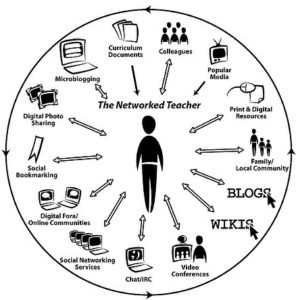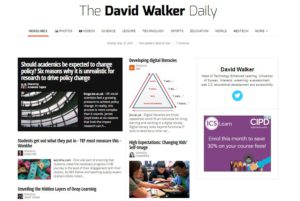
The Networked Teacher, flickr photo by courosa shared under a Creative Commons (BY-NC-SA) license
‘Connectedness’ is the very essence of the social web. Digital technologies have an important role in mediating connections but it is important to recognise that it is the connections that these tools facilitate that are important and not the tools themselves.
This notion was at the heart of Alec Couros’ seminal work on The Networked Teacher emerging from his PhD research and which has framed much of the discourse around connected education and the value of professional learning networks (PLNs).
Learner transitions
Strategies to support access to higher education and widen participation in tertiary-level education have driven an increased focus on supporting learner transitions to, within, and beyond university courses. This is especially the case in Scotland where Student Transitions represents the current focus of the Enhancement Themes in the Scottish HE Sector.
Social media and digital tools can be powerful enablers for transition, support meaningful connection between learners and their prospective institution; between learners, their peers and their teachers; and the professional communities they may eventually join.
We need to think about our own ‘connectedness’. Steve Wheeler has argued forcefully for the benefits of educators engaging with digital technologies as a means of facilitating connections with other educators and professional communities.
“…connected educators are in a more powerful position than those who are isolated. They have a greater ability to check their facts, call on support and find out new things when connected to their personal learning networks than they do isolated.” (Connected Educators)
The importance of connectivity is further highlighted through initiatives such as University College London’s Connected Curriculum, a university-wide approach to research-based teaching which makes connections “…across modules, programmes and beyond the classroom.”
Digital spaces provide an opportunity for individuals to coalesce around different topics or issues of professional interest. For postgraduate/early career researchers participation in online communities that have emerged on platforms such as Twitter, for example #phdchat or #ecrchat, have provided a space for
many to test ideas, share fears and garner moral support.

Online communities. flickr photo by jimcwang shared under a Creative Commons (BY-NC-ND) license
For those engaged in higher education teaching and scholarship similar communities have evolved as mechanisms to support professional dialogue and development such as Learning and Teaching in Higher Education chat #LTHEchat and #acwri (academic writing).
Professional groups in other online spaces such as LinkedIn and engagement with public audiences through approaches such as blogging provide a means for individuals to develop their professional ‘voice’, immerse themselves in the discourse of their professional community and perhaps most importantly to establish relationships with individuals within that community.
“We need to think about the ‘connectedness’ of professional communities…” (Boyle, Smyth & Walker, 2015).
Emerging pedagogies such as Student as Producer and the maker movement have active involvement of learners in authentic practices at their core. How do we design our curricula, our teaching and assessment activities, to support our learners to engage with professional communities and support their transition to employment? What skills do they need and what skills might they engender?
These approaches do not necessitate digital solutions but may compliment face-to-face practices and indeed represent part of a broader effort to widen participation to education through alternative delivery modes.
Tools such as Google Docs, WordPress, Blogger, Padlet and LinkedIn can all be used to facilitate collaboration. YouTube, WeVideo, Flickr, AudioBoom and Slideshare provide vehicles for connecting through sharing, commenting, remixing and repurposing.

Make your own Paper.li at http://paper.li
Curation and sharing can be achieved using tools such as Diigo, Flipboard (see Anne Hole’s Flipboard for an example), Pinterest, Pearltrees and paper.li (see The David Walker Daily for an example). See our A-Z of Apps for more information about these digital tools.
Irrespective of the tools we choose to use it’s the benefits of the connections they facilitate, the skills that they help develop and the ideas, resources and support they provide us with access to that are the true value.
References
- Boyle, L., Smyth, K. & Walker, D. (2015) Assessment Design and learner transitions: from programme entry and progression to entering professional practice. International Conference on Enhancement and Innovation in Higher Education, Glasgow.
- Couros, A. Flickr
- Wheeler, S. (2011) Connected Educators. Learning with ‘e’s



[…] Read the full story by University of Sussex Technology Enhanced Learning Blog […]